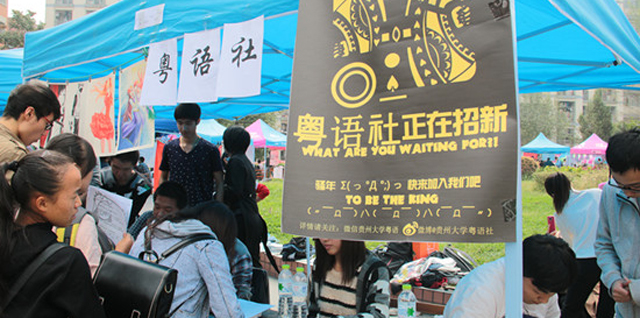
几十年前,如果你在北京的胡同口遛弯儿,你或许会听见许多本地人聊天时会在话尾加上 “儿化音”。
This sound is a major characteristic of the Beijing dialect, except “swallowing” *consonants–just think of “zhuangdianrtai” in Beijing dialect compared to China Central Television in Putonghua, also kown as Modern Standard Mandarin. However, none of these features can be heard that often among today’s Beijing dwellers. A recent report by the Ministry of Education shows that the Beijing dialect is declining among the younger generation.
这种“儿化音”是北京方言的一大特征,除此之外,“吞音”也是北京话的一大显著特点 —— 只要将北京话里的“装垫儿台”和标准普通话里的“中央电视台”相比较,你就能明白了。然而,在现今的北京居民口中,这些北京方言的特点都不如以往那么常见了。教育部近期发布的一份报告显示,在年轻一代中,北京方言正在衰亡。
The news doesn’t come as a surprise though, as previous studies have highlighted the “dialect crisis” in other parts of China as well.
尽管如此,这一消息也并非意料之外,先前的一系列研究也指出了中国其他地区的“方言危机”。
According to the UNESCO *Atlas of the World’s Languages in Danger, nearly 100 Chinese dialects are on the brink of extinction.
据联合国教科文组织发布的“全球濒危语言地图”显示,近100种中国方言处于消失的边缘。
He Hongzhi, of the Beijing Municipal Language Commission, attributes this problem to migration and the promotion of Putonghua.
北京市语言文字工作委员会办公室主任贺宏志将此归结于外来移民以及普通话的推广普及。
“With rapid social development over recent years, an increasing number of migrants with different dialects can be found all over China. However, people are encouraged to speak Putonghua between each other, threatening the existence of dialects,” he told Beijing Daily.
“随着近些年来社会的快速发展,人口流动性加大,各种方言遍布全国。因为人们之间多使用普通话交流,方言的存在遭到了威胁,”他在接受《北京日报》采访时表示。
Reflection of history
历史的映射
But rather than just letting the problem be, efforts are being made to preserve these local dialects because of the culture *heft they carry.
考虑到方言本身浓厚的历史底蕴,人们采取了许多措施来保护家乡方言,而非将问题置之不理。
“For many Chinese who live outside their hometowns, dialect is an
“对于许多背井离乡的中国人来说,方言是一个很重要的身份象征,不断提醒着他们故乡所在,”《晶报》评论员李跃写道。
Dialects also reflect history and embody local culture. The Beijing dialect for example, though being a language of the Han ethnic group, shows traces of Mongolian and Manchu languages. Mongolian and Manchu are ethnic groups who had ruled Beijing during the Yuan and Qing dynasties respectively. The Mongolian word hutong and the Manchu word Sachima (a common Chinese pastry) now appear in the Beijing dialect.
方言也反映了历史、体现了当地文化。以北京方言为例,尽管北京话是一种汉族语言,但它也体现了蒙古语和满语的痕迹。蒙古族和满族都曾先后在元朝和清朝统治中国。而蒙古语的胡同以及满语的萨琪玛(一种常见的中式点心)也在北京方言中留存了下来。
To preserve these valuable parts of history, the State Language Commission has maintained databases since 2008 to cover different local dialects, while many areas such as Beijing, Shanghai and Zhejiang province have established museums dedicated to local *lingo. The Beijing municipal education authority, similar to its counterpart in Shanghai, also plans to make the Beijing dialect part of its school-based curriculum.
为了保护这些珍贵的历史遗产,国家语言文字工作委员会从2008年开始,启动了涵盖多种不同方言的数据库建设,而诸如北京、上海以及浙江等地则建立起了相应的方言博物馆。北京市教育局也采取了和上海市教育局相同的举措,正计划将北京方言引入学校课程当中。
Individual effort
个人的努力
And it’s not just the government that is making an effort to maintain the country’s waning dialects – an increasing number of individuals are joining in the effort too. Wang Han, a well-known anchor for Hunan TV, has invested several million yuan into the research and protection of Hunan dialects, for example.
除了政府之外,越来越多的个人也加入到了保护濒危方言这一大军中来。比如,著名的湖南卫视节目主持人汪涵就已经投入了几百万元,用于湖南方言的研究及保护。
But all these efforts are still *insufficient in keeping dialects from fading away, according to Cao Zhiyun, professor of linguistics at Beijing Language and Culture University.
然而,北京语言大学语言学教授曹志耘却认为,这些努力对于阻止方言消失,还远远不够。
“What we’re doing now are mostly rescue works. A more effective measure to keep them alive could be using elements such as pop songs and the ‘celebrity effect’ to attract the young to use dialects,” he told Xinhua News Agency. “They need to realize that speaking [their local] dialect is something they can be proud of.”
“我们现在所做的,大部分都是救护工作。而让这些方言能够保持活力的更有效的办法是利用流行歌曲等‘名人效应’,来吸引年轻人使用方言,”他在接受新华社采访时表示。“年轻人需要意识到,说(自己的家乡)方言也能成为他们的骄傲。”
查看更多关于【英语时事】的文章


















